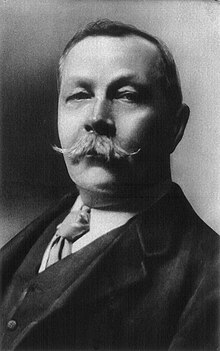About the Book: "The Adventure of Charles Augustus Milverton" is one of the 56 Sherlock Holmes short stories written by British author Sir Arthur Conan Doyle. It is one of 13 stories in the cycle collected as The Return of Sherlock Holmes and was published in 1904.

About the Author: Arthur Ignatius Conan Doyle was born on 22 May 1859 at 11 Picardy Place, Edinburgh, Scotland. From 1876 to 1881, he studied medicine at the University of Edinburgh, including a period working in the town of Aston (now a district of Birmingham) and in Sheffield, as well as in Shropshire at Ruyton-XI-Towns. While studying, Doyle began writing short stories. His earliest extant fiction, "The Haunted Grange of Goresthorpe", was unsuccessfully submitted to Blackwood's Magazine. His first published piece "The Mystery of Sasassa Valley", a story set in South Africa, was printed in Chambers's Edinburgh Journal on 6 September 1879. On 20 September 1879, he published his first non-fiction article, "Gelsemium as a Poison" in the British Medical Journal. In 1882 he joined former classmate George Turnavine Budd as his partner at a medical practice in Plymouth, but their relationship proved difficult, and Doyle soon left to set up an independent practice. Arriving in Portsmouth in June of that year with less than £10 (£900 today) to his name, he set up a medical practice at 1 Bush Villas in Elm Grove, Southsea. The practice was initially not very successful. While waiting for patients, Doyle again began writing stories and composed his first novels, The Mystery of Cloomber, not published until 1888, and the unfinished Narrative of John Smith, which would go unpublished until 2011. He amassed a portfolio of short stories including "The Captain of the Pole-Star" and "J. Habakuk Jephson's Statement", both inspired by Doyle's time at sea, the latter of which popularized the mystery of the Mary Celeste and added fictional details such as the perfect condition of the ship (which had actually taken on water by the time it was discovered) and its boats remaining on board (the one boat was in fact missing) that have come to dominate popular accounts of the incident. Doyle struggled to find a publisher for his work. His first significant piece, A Study in Scarlet, was taken by Ward Lock Co. on 20 November 1886, giving Doyle £25 for all rights to the story. The piece appeared later that year in the Beeton's Christmas Annual and received good reviews in The Scotsman and the Glasgow Herald. The story featured the first appearance of Watson and Sherlock Holmes, partially modeled after his former university teacher Joseph Bell. Doyle wrote to him, "It is most certainly to you that I owe Sherlock Holmes ... Round the center of deduction and inference and observation which I have heard you inculcate I have tried to build up a man." Robert Louis Stevenson was able, even in faraway Samoa, to recognize the strong similarity between Joseph Bell and Sherlock Holmes: "My compliments on your very ingenious and very interesting adventures of Sherlock Holmes. ... Can this be my old friend Joe Bell?" Other authors sometimes suggest additional influences—for instance, the famous Edgar Allan Poe character C. Auguste Dupin. A sequel to A Study in Scarlet was commissioned and The Sign of the Four appeared in Lippincott's Magazine in February 1890, under agreement with the Ward Lock company. Doyle felt grievously exploited by Ward Lock as an author new to the publishing world and he left them. Short stories featuring Sherlock Holmes were published in the Strand Magazine. Doyle first began to write for the 'Strand' from his home at 2 Upper Wimpole Street, now marked by a memorial plaque. In this period, however, Holmes was not his sole subject and in 1893, he collaborated with J.M. Barrie on the libretto of Jane Annie. Doyle was found clutching his chest in the hall of Windlesham Manor, his house in Crowborough, East Sussex, on 7 July 1930. He died of a heart attack at the age of 71. His last words were directed toward his wife: "You are wonderful." At the time of his death, there was some controversy concerning his burial place, as he was avowedly not a Christian, considering himself a Spiritualist. He was first buried on 11 July 1930 in Windlesham rose garden. He was later re-interred together with his wife in Minstead churchyard in the New Forest, Hampshire. Carved wooden tablets to his memory and to the memory of his wife are held privately and are inaccessible to the public. That inscription reads, "Blade straight / Steel true / Arthur Conan Doyle / Born May 22nd 1859 / Passed On 7th July 1930." The epitaph on his gravestone in the churchyard reads, in part: "Steel true/Blade straight/Arthur Conan Doyle/Knight/Patriot, Physician, and man of letters". Undershaw, the home near Hindhead, Haslemere, south of London, that Doyle had built and lived in between October 1897 and September 1907, was a hotel and restaurant from 1924 until 2004. It was then bought by a developer and stood empty while conservationists and Doyle fans fought to preserve it. In 2012 the High Court ruled that the redevelopment permission be quashed because proper procedure had not been followed. A statue honors Doyle at Crowborough Cross in Crowborough, where he lived for 23 years. There is also a statue of Sherlock Holmes in Picardy Place, Edinburgh, close to the house where Doyle was born.
My Review: I consider this one of the best short stories featuring Sherlock Holmes. In this story, Holmes is hired by the débutante Lady Eva Blackwell to retrieve compromising letters from a blackmailer: Milverton, who causes Holmes more revulsion than any of the 50-odd murderers in his career. Milverton is "the king of blackmailers" and he makes his living out of blackmail. He demands £7,000 (about £700,000 in 2010) for the letters, which would cause a scandal that would end Lady Eva's marriage engagement. Holmes offers £2,000, all Lady Eva can pay, but Milverton insists on £7,000. It is worth £2,000 to him to make an example of Lady Eva. Holmes resolves to recover the letters by whatever means necessary, as Milverton has placed himself outside the bounds of morality.
Holmes visits Milverton's Hampstead house, disguised as a plumber, in order to learn the plan of the house and Milverton's daily routine. He cultivates the acquaintance of Milverton's housemaid and even becomes engaged to marry her. This rather shocks Watson, but Holmes assures him that he has a hated rival who will step in when the plumber disappears. Holmes has learned where Milverton keeps his blackmail papers (a safe in his study), and plans to burgle Milverton's house that night. Watson comes along.
They break into the study, and Holmes opens the safe. But just then Milverton, who should be in bed asleep, enters the study. Holmes and Watson hide behind a curtain, while Milverton has a midnight meeting with a supposed maidservant offering to sell letters that would compromise her mistress.
The woman is actually one of Milverton's former victims, whose broken-hearted husband died when she wouldn't pay Milverton and he revealed her secret. Now she avenges her husband by shooting Milverton to death, then stamps on his face.
Watson instinctively begins to rush out and stop the shooting, but Holmes restrains him. Holmes understands, and Watson instantly realises, "that it was no affair of ours; that justice had overtaken a villain..." The woman runs away, and Milverton's household is roused by the shots. But Holmes takes the time to dump all of Milverton's blackmail papers on the fire in the fireplace, despite the risk of being discovered and caught.
Then Holmes and Watson escape through the garden and over the wall. Watson has to kick himself free from a pursuer who has grabbed his leg.
The next morning, Inspector Lestrade calls at Baker Street to ask for Holmes' help in investigating Milverton's murder, which he ascribes to the two burglars seen escaping over the garden wall. He has a description of one of them: "a middle-aged, strongly built man-square jaw, thick neck, moustache..." Holmes calls that vague. "Why, it might be a description of Watson!" he says, which amuses Lestrade. But Holmes refuses Lestrade's request: "my sympathies are with the criminals, and I will not handle the case."
Later, Holmes recognises the face of the woman who killed Milverton. He shows Watson her photograph displayed in a shop-window among those of other celebrities. Watson recognizes the name of her famous husband, but Holmes signals silence with a finger to his lips.
I recommend this book to all readers who appreciate a well written mystery story, mainly for those who love Sherlock Holmes.


No comments:
Post a Comment